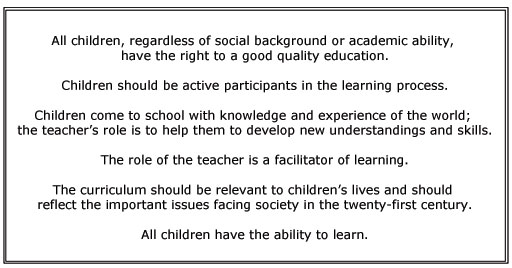2 What is a vision statement?
A vision statement is essentially a value statement. It summaries the moral purpose of the school and reflects a set of shared values. A good starting point in the process of establishing a vision for your school is to examine your own values and beliefs and the values embodied in the NCF 2005 and the RtE 2009.
The NCF 2005 sets out an ambitious programme for education in India and the RtE 2009 puts into place some of the structures that will support the implementation of the NCF 2005. The RtE 2009 also stresses the responsibility of a school to address the needs of all students and foster inclusion. Both are underpinned by a particular set of values (Figure 1).
Figure 1 The values underpinning the NFC 2005 and the RtE 2009.
The values in Figure 1 challenge some historically held beliefs. For example, in some schools:
- students from different castes are seated separately and given fewer opportunities to take part in the lessons
- male students are sometimes favoured over female students as their education is considered to be more important
- some teachers believe that students with rural backgrounds do not have the ability to learn
- teachers are often considered to be the experts providing knowledge and wisdom that students are expected to absorb.
As a school leader in India in the twenty-first century, your role is to translate the aspirations of the NCF 2005 and RtE 2009 into practice in your school. Establishing a shared vision that embodies the values set out in Figure 1 is the starting point.
In Activity 1 you will have opportunity to reflect on the values embodied in some vision statements and to reflect on the sort of behaviours that you can adopt that are consistent with the values that underpin the NCF 2005 and the RtE 2009, and therefore the vision for your school.
Activity 1: Thinking about values
If possible, you should do this activity with another school leader, or with your deputy.
Look at the vision statements in Table 1. Analyse each statement in terms of the underlying values that are implied. Which ones are consistent with the values that underpin the NCF 2005 and the RtE 2009?
| School and statement | What is valued? | Is this consistent with the NCF 2005 and RtE 2009? |
|---|---|---|
| Lahsuniya School: ‘Families and school work together to support children’s learning’ | ||
| Neelam School: ‘Every child in this school is encouraged to develop their full potential in a stimulating and caring environment’ | ||
| Panna School: ‘To ensure 100% success in end-of-school examinations’ | ||
| Moonga School: ‘Our vision is to provide a happy, caring and stimulating environment where children learn to make their best contribution to society’ | ||
| Mukta School: ‘To meet the needs of all its pupils’ | ||
| Manik School: ‘Our school is a place of excellence where children can achieve their full potential’ | ||
| Gomedha School: ‘To be the best school in the district’ | ||
| Pukhraj School: ‘To ensure that all students have the chance to go to university’ | ||
| Aakash School: ‘Every teacher strives for the best for every single child’ | ||
| Heera School: ‘We believe that every child is entitled to enjoy his/her childhood. They should be valued for their individuality, culture and heritage’ | ||
If members of your school community have historically held values and beliefs that are inconsistent with the NCF 2005 and REA 2009, you will not be able to change their views overnight. However, by adopting certain behaviours yourself and expecting your teachers to do the same, you will be able to create an environment where the values set out in Figure 1 will become established.
For each of the statements in Figure 1, identify some behaviours that you could adopt which will reinforce these values.
Discussion
Some of the statements in Table 1 fit the NCF 2005 and RtE 2009 statements very well, but some do not. For example, the desire for all students to go to university might appear to be aspirational, but is it realistic? The message is that going to university is more important than anything else; whereas in practice, it is not an appropriate ambition for some students. The statement from Heera School is certainly inclusive, but is it aspirational? The statements that seem to fit the criteria best are perhaps those from Neelam and Moonga Schools, as they emphasise wellbeing and the desire that all students achieve their full potential.
You can model inclusion values through talking to students and about students. The key resource ‘Involving all [Tip: hold Ctrl and click a link to open it in a new tab. (Hide tip)] ’ could be used to support your teachers in modelling inclusive behaviours.
Figure 2 Features of a good vision statement.
1 The importance of having a clear vision for your school


